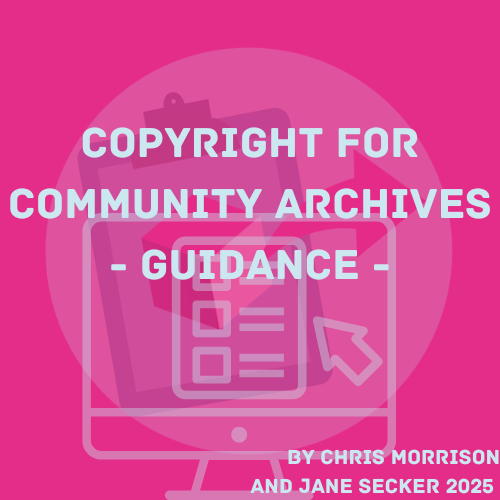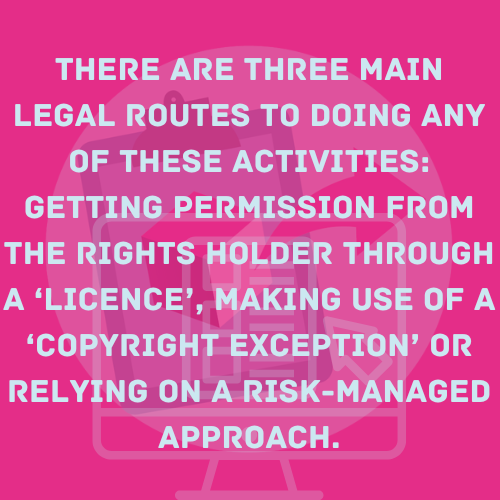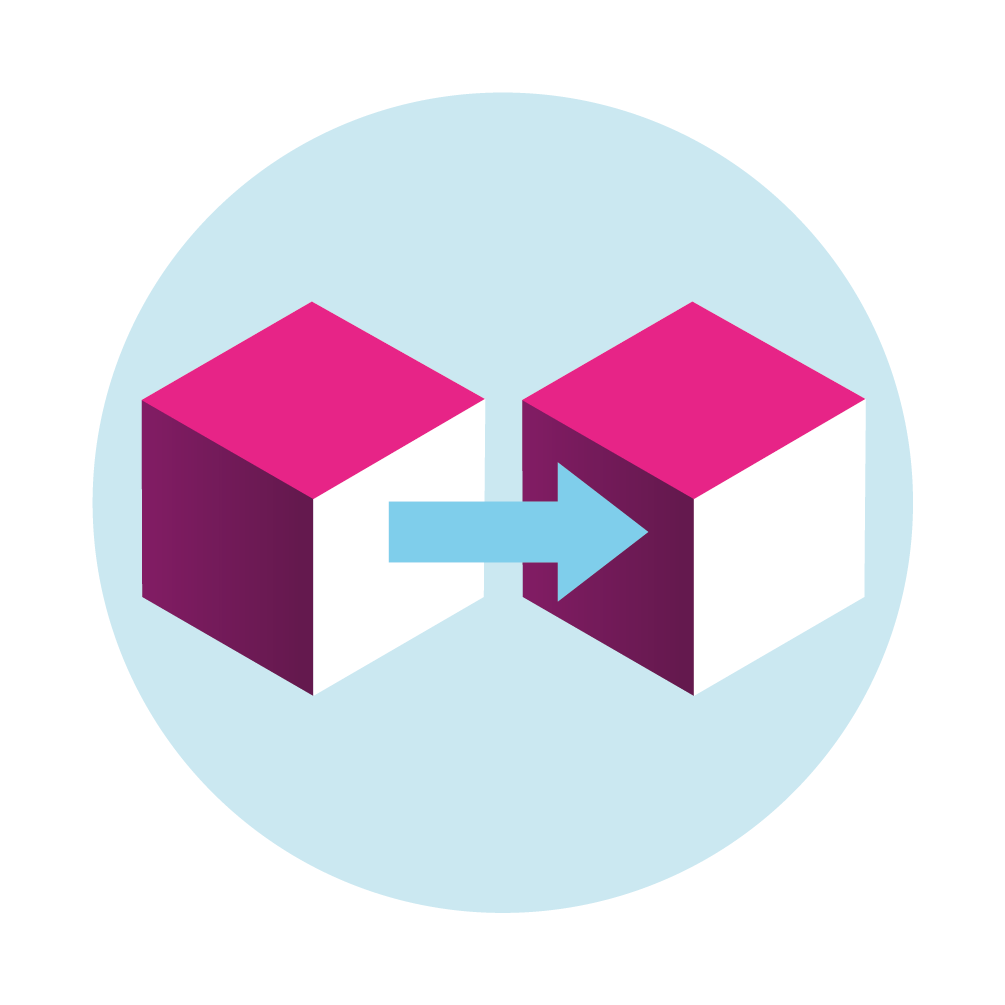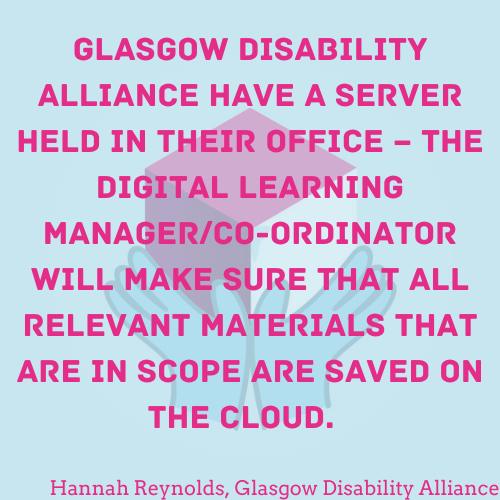A Guide to Copyright for Community Archives
Written by Chris Morrison and Jane Secker, 2025
 Introduction
Introduction
Copyright is an important consideration when working with digital collections in community archives. Although working with copyright and related rights can become quite involved, the basic concepts behind how copyright works and applies to collections in community archives are quite straightforward.
Copyright works and usages
Copyright is a type of intellectual property right - a set of legal rights that regulate what people can do with the outputs of human creativity and innovation. Copyright protects a range of creative works such as books, letters, photographs, artworks, music, software, sound recordings and films.
In the UK the relevant legislation is the Copyright, Designs & Patents Act 1988. Copyright automatically arises in any sufficiently original creative work and will last for a set period of time - typically 70 years after the death of the author (or last author to die). However durations will differ depending on whether the work was published, the date it was created and the type of work it is. The National Archives have produced some very helpful flowcharts to work this out.
Copyright law regulates certain, specific activities which are called ‘restricted acts’ in the relevant legislation. These are:
-
Copying a work
-
Issuing copies to the public
-
Rental or lending
-
Public performance
-
Communicating works to the public - which includes broadcast and online uses
-
Adaptation
Copyright licences, exceptions and risk
Licences
 There are three main legal routes to doing any of these activities: Getting permission from the rights holder through a ‘licence’, making use of a ‘copyright exception’ or relying on a risk-managed approach. In practice most community archives will need to use a combination of all of these:
There are three main legal routes to doing any of these activities: Getting permission from the rights holder through a ‘licence’, making use of a ‘copyright exception’ or relying on a risk-managed approach. In practice most community archives will need to use a combination of all of these:
Licences present the lowest level of risk as it means using the work with the permission of the copyright holder. These can be formal, legal contracts or informal agreements. They can be paid for or provided for free. They will often have limitations as to who is able to benefit from them, for how long and in which country. Community archivists may use a range of different licences - for example subscriptions to digital resources and software from third party suppliers.
Community archives might also want to apply licences to the content they provide to their audiences, to indicate what people are allowed to do with the digitised collections. This is something their organisation will need to make some important and thoughtful decisions about which involve considering a range of factors. For example, whether the underlying works are in copyright or whether to apply an open licence to the works.
Licences can also be quite permissive - for example, the Creative Commons suite of licences which encourage and enable the ‘open’ sharing of copyright material. Creative Commons are the most widely used set of ‘open’ licences and they are made up of different components. For example they all require that users of the work attribute the author or creator, but some have non-commercial restrictions or prohibit the making of derivative works.
Copyright Exceptions
However, licences are not always available or appropriate. Therefore copyright exceptions are an essential part of the balance between the exclusive rights of the copyright owner and the wider social and cultural benefit of people and organisations being able to use copyright works in ways that are fair or reasonable without having to get permission. For example, UK law has copyright exceptions that allow libraries and archives to make copies of works for preservation purposes subject to certain conditions.
Fair Dealing and Fair Use
Many people are aware of the term ‘fair use’, but this is actually a doctrine of US copyright law. The UK equivalent is the concept of ‘fair dealing’ which is not defined in the legislation, but is a feature of a number of copyright exceptions. Fair dealing is intended to serve a similar purpose to fair use, but is more limited in that it must be aligned with a specific type of activity (e.g. parody or quotation).
Using a work in a way that would be considered ‘fair dealing’ means ensuring that if you use a work without the permission of the copyright owner, then this doesn’t undermine their legitimate interests. For example, if you were to provide free access to a work that the copyright owner is selling or licensing elsewhere, and as a result you were undermining sales, then this is likely to be unfair and therefore an infringement of copyright. Many uses of copyright material in education and research, such as using illustrative excerpts or images, are likely to be covered by fair dealing. However, it is important to consider each use on a case by case basis.
Risk Management
Risk management refers to the process of assessing whether to digitise and make works available where there is some uncertainty as to the legal status of a work or the communication of it. It involves asking the following questions:
-
What’s the likelihood that your activity infringes copyright?
-
What is the likelihood that the copyright owner will discover and object to your activity?
-
What would the financial and reputational impact be if the copyright holder was to take action against you or your organisation?
Orphan Works
Risk management is now an established route for archives to follow when dealing with diverse collections which may include what are known as ‘orphan works’. These are works where the copyright holder cannot be identified or contacted. If you decide you want to digitise an orphan work you can apply for a licence via the UK Government’s Orphan Works Licensing Scheme. Whether you decide to use risk management, apply for a licence or a combination of the two, you must do a ‘diligent search’ to try and track down any rightsholders. Diligentsearch.eu is a useful tool that can help you.
Worked Example
An amateur historian has donated her collection to a local historical society of which she was a member. The collection includes letters, books, journals, photographs, ephemera and videos in a range of different formats. How would the society archive address the copyright considerations of digitising the collection, preserving it and making it available to the public?
Here are some things to consider:
-
Are the items in copyright? If not, no rights clearance is needed
-
Who owns the copyright in the collection items? Can you get permission from the historian for the archive to use and reuse content they have created?
-
If relying on preservation exceptions, are the items now in the archive’s ‘permanent collection’?
-
Are any of the collection items ‘orphan works’ and if so, what is the archive’s due diligence process?
-
Should the archive use a risk managed approach, or is the UK Orphan Works Licensing Scheme more appropriate?
In Summary
-
Copyright automatically arises in any original creative expression recorded in a fixed form
-
Copyright only needs to be considered if you are doing a ‘restricted act’
-
Copyright licences come in many different forms from closed to open
-
Copyright is not just about licences; exceptions allow for many preservation activities
-
Copyright exceptions for preservation allow community archives to digitise in copyright material, but not necessarily make them publicly available online
-
In many situations you will need to think about ‘risk management’ – uncertainty is inherent in copyright law and is also desirable
Copyright for Community Archives Recording
Copyright for Community Archives PowerPoint and Script
Useful further reading
 Deazley, R (n.d) Copyright User.org Archives and Preservation Available at: https://www.copyrightuser.org/educate/archives/
Deazley, R (n.d) Copyright User.org Archives and Preservation Available at: https://www.copyrightuser.org/educate/archives/
Bodleian Copyright Guidance - https://www.bodleian.ox.ac.uk/ask/copyright
Copyright, Designs & Patents Act 1988 - https://www.legislation.gov.uk/ukpga/1988/48/contents
Copyright Literacy - https://copyrightliteracy.org/
Copyright User – https://copyrightuser.org (see in particular the sections on Archives and Preservation and Orphan Works)
EnDOW Due diligent search tool - https://diligentsearch.eu/
Intellectual Property Office (2020) Orphan works and cultural heritage. Available at: https://www.gov.uk/guidance/orphan-works-and-cultural-heritage-institutions
TNA Copyright Duration – https://www.nationalarchives.gov.uk/information-management/re-using-public-sector-information/duration-copyright/
Credits
This work is © Chris Morrison and Jane Secker 2025 and is licensed CC BY-SA
Keep Your Content – Level 1
 |
Storage ReviewAll technology has a shelf life, and this includes the medium or devices that your content is stored on. For example, external hard drives tend to have around a five-year life span and cloud storage will only be accessible as long as the bill is paid. Removable media, such as CDs and DVDs, can be easily lost or damaged. Hard disk drives can malfunction or break. Legacy storage media, such as floppy disks, may not be supported by contemporary computer environments. |
Just One Thing
Check that your current storage media for all your content is still accessible and functioning properly. Bear in mind that storage media can sometimes fail suddenly and unexpectedly. Replace or upgrade as needed to ensure your content stays accessible. Replacing storage before you have issues accessing content will save both time and money in the future. This includes making sure that payment for any cloud or off-site storage is up to date and those involved know what they need to do to keep it active.
Use this template to keep track of the storage you have and any changes you make.
Make Copies - Level 3
 |
Check your copiesHaving more than one copy is one way of ensuring your files will remain accessible over the long term. However, it is also important to regularly check that the content you are storing hasn’t been changed or damaged in some way. Digital content is more fragile than physical records and will become obsolete or “rot” as technology and formats change or if storage media becomes damaged. The process of file checking is called fixity checking. This short clip explains why and how this is caried out. There are several ways of doing this. |
If you store your content in a cloud environment, such as Amazon AWS or Microsoft 365, your data will be backed up and basic checks carried out as part of the subscription you pay. This does not produce reports, so you won’t know if any files have been changed or fixed during the checks, but your files should remain operational. You can also pay extra on your subscription to have more in depth checks performed and logged.
If your files are stored on another medium, or you want to run a check yourself, the easiest option is Fixity Pro. An easy-to-use program which allows you to schedule and run your own fixity checks while providing detailed reports. Fixity Pro is $50 (or your local equivalent) per year, so is a cost-effective option. This video shows you how Fixity pro works.
Corz is another tool option, but make sure you read the listed disadvantages before you attempt to use it as it may not be suitable for your purposes. There are other software options available which are free to run, but they can be complex to use, and in some cases, knowledge of your computer command line or terminal, or coding experience may be needed to make them work
Keep Your Content – Level 2
 |
Storage OptionsNow that you know the storage you have is functional and accessible, it is worth looking into what options you have for long term storage of your content and any copies you make. Technology is constantly changing and researching the options currently available could not only save your group money but may also lead to a more suitable storage solution for your content. Some of the storage options currently available are detailed below along with some pros and cons of each. |
External Hard Drives
External Hard Drives are the same storage drives used inside laptops and desktop PCs, but they are encased independently and connect to a computer via an external connection, usually USB cable.

Third Party Cloud Storage Provision
These involve paying a fee (usually monthly) to a third-party service provider, to send copies of your digital content over a network. The provider may also maintain backups for you as part of the service.

Network Attached Storage
A NAS is a storage device connected to a network that allows storage and retrieval of data from a central location, usually on your premises. You can control access permissions to further protect your content.

Keep Your Content – Level 3
 |
Storing Your ContentNow that you know what storage you currently have, and you know your options, it makes sense to look at what your current storage requirements are and how they might grow over time. Information gathered in your Digital Asset Register can help with this process. It will enable you to look at the best storage option for your content and put a plan in place to move your content should you ever have the funds and resources to do so. |
Control Your Content - Level 1
 |
Exit StrategyHaving your digital collections locked into a particular system, app, service, or website can be a huge risk. Especially if that system or service is closed down, or you simply want to move it elsewhere. A common example is the use of Facebook groups by community organizations. They are relatively easy to setup and engage an audience, but if digital photos and other information is collected on a Facebook group, it’s very hard to extract that information so that it can be shared or preserved elsewhere. |
It is therefore critical ensure that any software, system, or website that you use has a clear exit strategy that details how you will get your data back if you decide to stop using them.
Just One Thing
If you decide to use a system to manage, preserve, or provide access to your content, make sure you understand the process to get your information back. This information should be included as part of any contract you sign. If it is not there, do not sign the contract and reassess your options.
Make Copies - Level 2
 |
The 3 – 2 – 1 RuleKeeping a copy (or copies) of your digital content is a great step towards keeping your content safe. But just in case the unthinkable happens and the original digital file and the copy become unusable in some way, it’s best to have contingency in place. The 3 - 2 - 1 copy rule offers more piece of mind that at least one of your copies will be safe. This rule is described in more detail below. |
The 3 – 2 – 1 rule is simple-
| 3 copies of each file | On 2 types of storage medium | With at least 1 copy offsite |
 |
||
In an ideal world, using the 3 – 2 – 1 rule, you will make three copies of each file you have. These copies will then be split and stored on different storage mediums, for example, one on an external hard drive and two copies in cloud storage. At least one of these copies will be held off site. In this example, cloud storage ticks this box, but if you store your content on a laptop and an external hard drive, the external hard drive should be stored in a separate location from the laptop so the two cannot be damaged at the same time.
Storing files in this way does mitigate risk to your content, but it is not always possible. As many copies as you can manage stored separately from each other is still good digital preservation.
Next Steps
Now that you have several copies of each file, your content is automatically better protected. However, it is still important to carry out regular checks on your content to keep it accessible and usable. Level 3 will tell you more about how to do this.
Make Copies - Level 1
 |
Back up your content offsiteA huge range of threats can endanger your digital collections and the work that’s been put in to create them. Whether it’s computer failure, fire or flood, or simply failing to continue to pay for a cloud storage account, it’s important to not keep all your eggs in one basket. Making more than one copy of digital collections creates means your content is more likely to remain accessible. |
Just One Thing
A great way to start is to back up your digital collections to an offsite location. There are a range of ways to do this. Backing up to several external hard drives that are kept at different locations and rotated monthly is a manual approach. Replicating your content to the cloud using a simple cloud provider account is a more automated alternative but may have a higher cost.
Next steps…
Whichever method you choose, it’s critical to ensure that the backup process continues over time and that the additional copy, or copies, that you create are not forgotten about. At the next level we’ll consider how to replicate your content in a way that will mitigate all the common threats and ensure your digital collections will survive the test of time.
Control Your Content - Level 2
 |
How to talk to SuppliersIf you are considering using any kind of software, system, or service to help you preserve and provide access to your digital collections, you need to make sure that you know what you need. Being able to talk to suppliers or creators will allow you to ask the right questions to make sure you get the most out of each conversation and ensure you get the product that is right for you, regardless of whether the software is free to use or paid for. |
The approach we recommend here is to take a holistic view of how you would like to manage your collections and what technological solution would enable you to do that. Considering the points below will help you to do this.
These points are broken down by the stages of the lifecycle to help you work through each step of your process and work out what is required.
Creation / Collection
|
Selection –
|
Description
|
Management –
|
Storage –
|
Preservation –
|
Use –
|
|
Control Your Content - Level 3
 |
Check Your ContractsIf you decide to use a commercial software or hardware provider for any aspect of your digital preservation work, it is very likely that you will need to sign a contract to agree to the company’s terms of service. It is important that you understand what you are signing and know exactly what will happen to your content once it is stored or processed by an external provider. |
Knowing how your data will be processed by the company is important as small print could be included within contracts that allows them to sell your contact information, or in some cases, use your content for something you don’t want it to be used for. If you are unsure, ask for help from your local or national archive who can offer advice and explain the jargon used to help to understand exactly what is being signed.
Subcategories
Template for building a Business Case
This section provides guidance on the content that will be useful to include in your business case, but it will likely need to be adapted to the structure used in your organization’s template.









































































































































